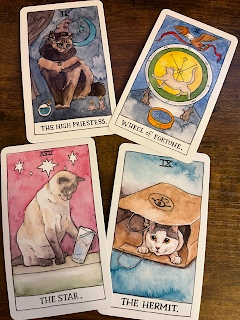Telling the Story
Let's talk about spreads
As mentioned in a previous entry, there are as many spreads as there are Tarot readers (and likely many more). That being said, I have found that the easiest spread for beginners is a three-card spread. A spread involves cards in particular positions and a predetermined relationship between those positions.
There are many possibilities as to how the positions in a spread can be defined, but it's important to decide upon the positions in the spread you're using prior to reading.
My favorite examples of three-card spreads are:
My favorite examples of three-card spreads are:
- Past, present, probable future
- Situation, action, probable outcome
- What I know, what is hidden, what I need to integrate
Again - you can define the card positions in the ways most meaningful to you, but stick to those definitions throughout the reading. You can always use a different spread next time!
The definitions of each position are so important because they will dictate how you tell the story.
Let's look at the three cards in the picture (from the Osho Zen Tarot). These cards correspond to the Page of Pentacles, the Ace of Wands, and the Ten of Cups in the traditional Rider-Waite deck.
Let's look at the three cards in the picture (from the Osho Zen Tarot). These cards correspond to the Page of Pentacles, the Ace of Wands, and the Ten of Cups in the traditional Rider-Waite deck.
Now, let's say that we decided before shuffling and pulling that these cards represent (left to right) the past, the present, and the probable future. I'm choosing this spread because most of us understand the basic elements of a story: beginning, middle, end. Thus, this will allow us to practice weaving the cards together into a cohesive message.
Weaving it all together
What I'd encourage you to do is to write down your impressions of each card, independent of the card's position. If you have a keyword chart, add those keywords. Once you're written this down (keep it short; we just want a "taste" of the card's meaning), you can begin to move through the spread and pull those elements together.
I've created my own story about these three cards, and your story will differ because you bring your own unique interpretations of symbols and your personal belief systems into play. Try to keep the story short and focused for the time being until you begin to feel more comfortable with the card meanings. It's helpful to know the focus of the querent (if reading for others) but it's not required and won't render the reading any less meaningful.
I've created my own story about these three cards, and your story will differ because you bring your own unique interpretations of symbols and your personal belief systems into play. Try to keep the story short and focused for the time being until you begin to feel more comfortable with the card meanings. It's helpful to know the focus of the querent (if reading for others) but it's not required and won't render the reading any less meaningful.
Page of Pentacles: I see someone who is reflecting back on the beginning of their journey to discover what they want to create (likely some combination of skills, knowledge, and abilities) and figuring out what they need to learn in order to get there. Perhaps they were a student or apprentice moving in the direction of their goals but were in the very early stages.
King of Wands: While they may have accomplished a great deal of worldly success and are likely in a leadership position, they may now be considering their work from a more creative perspective. Perhaps they are looking for opportunities to engage in activities that bring them more joy and satisfaction.
Ten of Cups: This will be a good move for them, because they will be happier and more satisfied in all areas of their life. Everyone in their life will benefit from this perspective shift and reprioritizing of fun, most of all themselves.
Can you see how these cards have been easily woven together into a simple story? Now, these happen to be random cards I selected. This all becomes more meaningful when you are actually performing a reading.
King of Wands: While they may have accomplished a great deal of worldly success and are likely in a leadership position, they may now be considering their work from a more creative perspective. Perhaps they are looking for opportunities to engage in activities that bring them more joy and satisfaction.
Ten of Cups: This will be a good move for them, because they will be happier and more satisfied in all areas of their life. Everyone in their life will benefit from this perspective shift and reprioritizing of fun, most of all themselves.
Can you see how these cards have been easily woven together into a simple story? Now, these happen to be random cards I selected. This all becomes more meaningful when you are actually performing a reading.
I hope this helps! As always, ask any questions in the comments.




Comments
Post a Comment